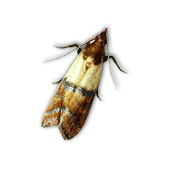General Characteristics:
-Adult moths are about 8 - 10mm long
- Wing spread is about 18 to 20mm
- (Viewed from above with the wings folded over the back) the outer 2/3 of the wing appears bronze in colour and the inner 2/3 of the wing is light gray to yellowish
- The head and thorax are reddish-brown and the hind wings are gray
- The larvae length is about 12.5mm when mature, have brown heads and are dingy white in colour (sometimes have a green or pink hue)
- Only larvae are destructive feeding on grain related products
Reproduction:
- Adults do not feed and are only responsible for reproduction
- Life cycle (egg to adult) is completed in 40 – 55 days depending on temperature
- Adult female may lay from 60 – 300 eggs on food material either loosely or in small clusters
- Eggs hatch in 2 – 14 days
Signs of Infestation:
- Close examination of susceptible foods for exposed adults is an important part of locating infestations
- Damaged dry foods and/or presence of adults or larvae may be signs of infestation
- Adults generally fly at night and are attracted to lights and may be observed resting on walls or bins
- Larvae leave silky strands as they move which can be observed on the top of raw product
Control Techniques:
- Proper disposal in sealed containers (following all local laws) is an effective
control method
- To prevent infestation, inspect all grain related dry foods carefully upon purchase and store in air tight containers
- Good sanitation procedures will help prevent infestations
- Pheromone traps which use a sex attractant can assist in disrupting adult reproduction
- Insecticides and fumigants may be used for existing infestations ACCORDING TO LABEL SPECIFICATIONS AND IN ACCORDANCE WITH FEDERAL, PROVINCIAL AND MUNICIPAL LAWS
Please click here to contact a Focus Pest Control professional to inquire about further treatments for this pest species.
References:
Benett, Gary W., et.al.. Truman’s Scientific Guide to Pest Control Operations. Duluth: Advanstar Communications, 1988. p. 215.
“Indian Meal Moth”(On-line). Penn State College of Agricultural Sciences – Entomology. Accessed Jan. 13, 2010 at http://ento.psu.edu/extension/factsheets/indian-meal-moth.
“Ohio State University Extension Fact Sheet (Entomology) - Indian Meal Moth” (On-line). Ohio State University Entomology. Accessed Jan. 13, 2010 at http://ohioline.osu.edu/hyg-fact/2000/2089.html.
Disclaimer:
The Focus Pest Control ‘Pest Library’ is an educational resource written largely to educate the general public about common pests in Ontario. The Focus ‘Pest Library’ does not include all species in Ontario, nor does it include the most recent scientific data about species we describe. Though we edit our accounts for accuracy, we cannot guarantee all information in those accounts. While Focus Pest Control staff and contributors provide references to books and websites that we believe are reputable, we cannot necessarily endorse the contents of references beyond our control.
(Back to top)
|


